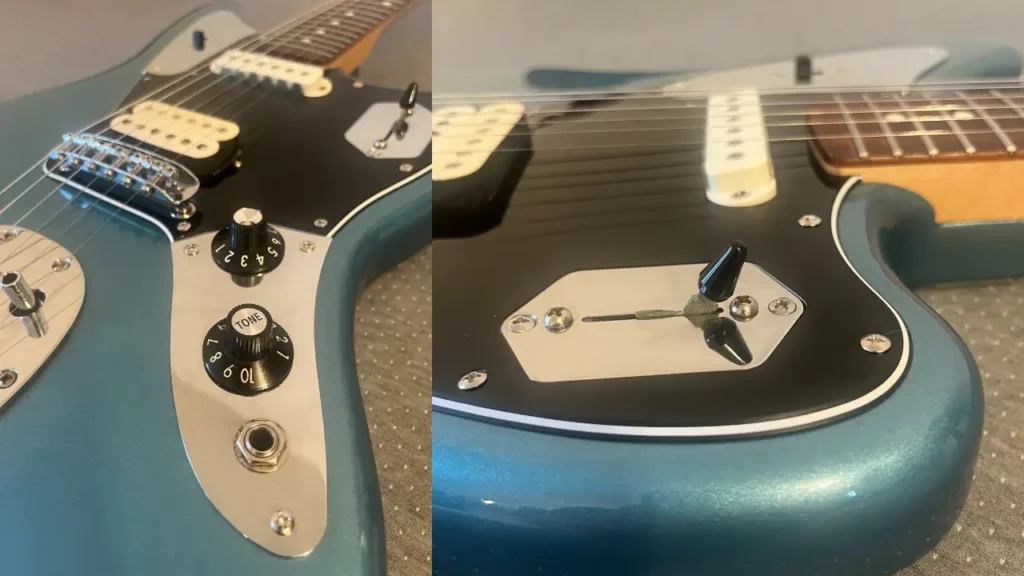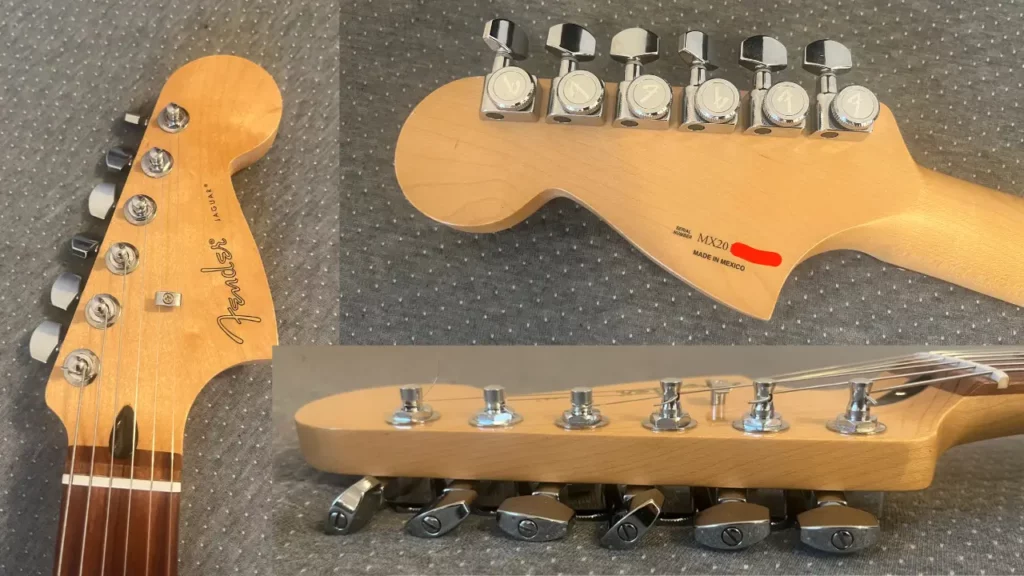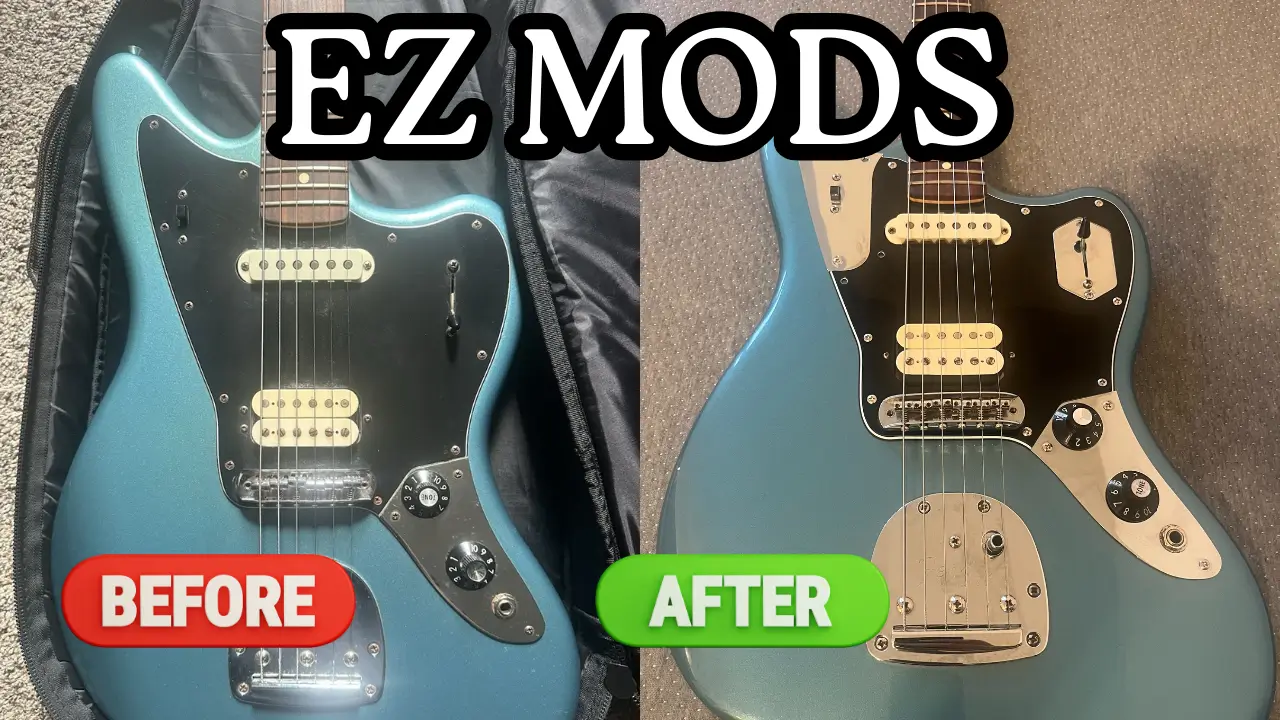Hey there, fellow guitar enthusiasts! If you’re like me, always tinkering with your gear to get that perfect blend of modern reliability and classic style, then you’re in for a treat. Today, I’m diving deep into my experience modding a Fender Player Jaguar. This isn’t just any upgrade—I’m talking about cosmetic tweaks that transform this affordable axe into something that screams vintage Jaguar charm. From swapping out the pickguard to adding chrome accents and locking tuners, these changes make a world of difference without touching the core electronics. And to make it even better, I’ve embedded the video below where I walk through the process step by step. Whether you’re searching for Fender Jaguar mods, Player series upgrades, or tips on sourcing rare guitar parts, this post has you covered. Let’s get into it!
Related Posts:
- Squier Classic Vibe Custom Telecaster SH with Bigsby: Vintage Tones Meet Modern Magic
- Hipshot Grip Lock Tuners Quick Look – VIDEO
- Squier Bullet vs Sonic Mustang HH Unique Differences VIDEO
Why Mod the Fender Player Jaguar?
I picked up my Fender Player Jaguar used for a steal, and right away, I knew it had potential. The original Player series comes with a humbucker in the bridge and a single-coil in the neck, which gives it a versatile tone perfect for everything from indie rock to surf vibes. But aesthetically? It felt a bit modern and stripped-down compared to the iconic Jaguars of the past. That’s where the mods come in. I wanted to add those shiny chrome plates and a new pickguard to mimic the traditional Jaguar look—think Kurt Cobain-era cool without breaking the bank.

Modding guitars like this is a rite of passage for many players. It personalizes your instrument, improves functionality, and can even boost resale value. For the Fender Player Jaguar specifically, these cosmetic upgrades address some of the design shortcuts Fender made to keep costs low. No rhythm circuit switches? No problem—I focused on visuals that enhance the overall appeal. If you’re new to guitar modifications, don’t worry; these are beginner-friendly and mostly plug-and-play. Plus, keeping the stock electronics means you retain that punchy humbucker split-coil capability, which I love for its tonal flexibility.
In the video below, I show you the before-and-after, highlighting how these changes elevate the guitar’s appearance. Check it out for a visual walkthrough—it’s short, sweet, and packed with tips.
Breaking Down the Mods: Step-by-Step Upgrades
Let’s start with the star of the show: the pickguard. The stock one on my Player Jaguar was functional but bland. I swapped it for one that would fit the new chrome pieces and was still cut for a humbucker and traditional Jaguar pick up.(whatever color suits your style—options abound). This not only covers the body cutouts but also ties into the vintage aesthetic. Sourcing a compatible pickguard wasn’t straightforward; many online listings are for standard Jaguars, not the Player series with its unique routing for the humbucker and three-way switch. After some digging, I found reliable spots like specialty guitar parts sites that offer multi-layer guards in various colors. Pro tip: Measure twice before buying to ensure it fits over the existing electronics cavity.
Next up, the chrome switch plates. These are what really sell the traditional Jaguar illusion. I added a chrome plate for the three-way pickup selector and another for the humbucker split-coil switch. On the upper horn, I installed a chrome accent piece that’s reminiscent of higher-end models like the American Performer Jaguar. This part was tricky to find—I ended up ordering from an international seller because domestic options were scarce. But the result? A sleek, polished look that catches the light just right during gigs. If you’re modding a Fender Player Jaguar, these plates are essential for that ’60s offset vibe.
Then there are the Fender staggered locking tuners. Oh man, these were a game-changer for playability. The stock tuners on my Jaguar were decent, but they didn’t hold tune as well during aggressive bends or tremolo dives. The staggered design means varying heights for better string break angle over the nut, reducing buzz and improving sustain. Installation was a breeze—no drilling required; they dropped right in as a direct replacement. I went with the locking version for quick string changes, which is a must if you’re like me and hate downtime during setups. You can grab these from most major retailers, but I recommend checking for staggered vs. non-staggered options.

I also tossed in a different string tree for better string alignment, but that’s a minor tweak. Overall, these mods cost me under $160, and the transformation is night and day. My Player Jaguar now looks like it could sit next to my Classic Player model without skipping a beat.
Comparing Fender Jaguar Versions: Which One Are You Modding?
One thing I noticed while researching these upgrades is how Fender keeps tweaking the Jaguar lineup, which can make modding confusing. Let’s break it down for clarity—especially if you’re searching for Fender Player vs. Classic Player Jaguar differences.
The original Player series (like mine) has a simplified control layout: no rhythm circuit switches but has one switch for a coil spit, a modern headstock logo, and body routing only for the basic switches. The tremolo plate sits further from the bridge like vintage specs, which affects string action slightly.
Enter the Player 2 series—more traditional with single-coil pickups all around, but still no rhythm controls. The pickguard covers a blank upper bout since there’s no cutout for extra switches. If you’re modding one of these, you’ll need to route the body if you want to add vintage-style electronics, which I avoided to keep things simple.
Then there’s the Classic Player Jaguar, produced from about 2008 to 2020. This one’s a beast with dual humbuckers, rosewood fretboard (on some models), and all the chrome goodies stock. The headstock sports the classic logo I adore, and the trem plate is positioned closer to the bridge for better leverage. Some versions switched fretboard woods due to CITES regulations, but rosewood is back now. Fender renamed it later (I think to the Vintera series or something similar—popping it up in the video), but the essence remains.
Key differences to note for mods:
- Headstock Logos: Player series is modern; Classic is vintage—can’t change that easily, but decals exist if you’re brave.
- Tremolo Positioning: Affects playability; vintage is further down, which I prefer for arm comfort.
- Body Routing: Player 1 has partial cutouts; Player 2 none at all—plan accordingly for advanced mods.
- Pickups and Controls: Humbucker vs. singles; no rhythm switches on newer models means easier cosmetics but less versatility out of the box.
If your Jaguar is from the rosewood era, you’re golden for that warm tone. Mine has pau ferro, but the mods distract from any shortcomings.
Sourcing Parts: My Hard-Won List and Tips
Finding these Fender Jaguar parts online was the biggest hurdle—I spent hours scouring sites before compiling a list. Amazon and eBay have the basics like chrome three-way plates and locking tuners. For the upper horn chrome piece, I turned to third-party international sellers (think UK or Japan-based shops). The pickguard came from a custom guitar parts website with color options galore.
Here’s my curated list for easy shopping:
I link directly to where I bought mine—super handy if you’re replicating this.
Pickguard: Parts For US Fender Jaguar Guitar Pickguard SH Humbucker Pickups Scratch Plate
Chrome Switch Plates: KAISH Electric Guitar Pickup Selector Blade Switch Plate Control Plate for Squier/Marr Jaguar Guitar Chrome (affiliate link)
Upper Horn Chrome: One Slide Switch plate,for Fender Jaguar Custom,Chrome Finish
Locking Tuners: Fender Deluxe Locking Staggered Guitar Tuners, Vintage Buttons, Chrome (affiliate link)
String Tree: Fender Ultra String Guides
Miscellaneous parts for your Jaguar Guitar (affiliate link)
Prices vary, but expect $20 per piece except for the tuners which are like $70. Always verify compatibility with your series to avoid returns.
“We are a participant in the Amazon Services LLC Associates Program, an affiliate advertising program designed to provide a means for us to earn fees by linking to Amazon.com and affiliated sites.”
Final Thoughts: Is Modding Worth It?
Absolutely! After these Fender Player Jaguar modifications, my guitar feels reborn. It’s got the vintage swagger of a traditional Jaguar with the reliability of modern manufacturing. No more slipping tuners, bland plastics, or missing chrome— just pure offset goodness. If you’re into electric guitar customization, Jaguar guitar upgrades, or even just Fender mods on a budget, give this a shot. It took me a few hours and the satisfaction is immense.
Got questions? Drop them in the comments below the video or here. What’s your favorite Jaguar mod? Share your stories—I’m always up for more tinkering ideas. Thanks for reading, and rock on!
Related Posts:




